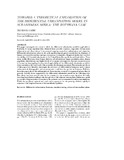| dc.contributor.author | Gwebu, T.D. | |
| dc.date.accessioned | 2011-12-06T09:16:11Z | |
| dc.date.available | 2011-12-06T09:16:11Z | |
| dc.date.issued | 2006 | |
| dc.identifier.citation | Gwebu, T.D. (2006) Towards a theoretical exploration of the differential urbanisation model in Sub-saharan Africa: The Botswana case, Tijdschrift voor Economische en Sociale Geografie, Vol. 97, No. 4, pp. 418–433 | en_US |
| dc.identifier.issn | 1467-9663 | |
| dc.identifier.uri | http://hdl.handle.net/10311/956 | |
| dc.description.abstract | This paper investigates the extent to which the differential urbanisation model is applicable to
Botswana by using empirical data obtained from periodic censuses, supportive documentary
information and observations from personal on-going research on urbanisation and migration.
Differential urbanisation refers to the cyclic spatio-temporal growth trends that the elements of
human settlement hierarchies undergo, in response to migration. Empirical studies have verified the validity of differential urbanisation in the United States, Europe, India and South Africa. These
areas, unlike Botswana, have longer histories of urbanisation, larger population sizes, denser
population distributions, and higher levels of economic development. Current research interest is focused on investigating the theoretical applicability of the differential urbanisation model to those countries at the lower end of the economic development spectrum. The rationale and thrust
of this paper is to therefore investigate the relevance of differential urbanisation under unique
environmental, demographic and socio-economic conditions that pertain to Botswana. Evidence
from the paper shows that urbanisation in Botswana has occurred in sequenced phases that, in general, resemble those suggested by the differential urbanisation model in the following ways. First, there has been concentration in the primate city due to mainstream migration. Secondly,
there has been fission leading to the fast growth of the adjacent intermediate settlements, partly
as a result of deglomeration economies at the primate core accompanied by substream migration.
Third, the peripheral regional and rural centres appear to be now growing relatively rapidly, in
response to the implementation of decentralisation policies. | en_US |
| dc.language.iso | en | en_US |
| dc.publisher | Blackwell Publishing Ltd, http://onlinelibrary.wiley.com/journal/10.1111/(ISSN)1467-9663 | en_US |
| dc.subject | Differential urbanisation | en_US |
| dc.subject | Botswana | en_US |
| dc.subject | Empirical testing | en_US |
| dc.subject | Advanced intermediate phase | en_US |
| dc.title | Towards a theoretical exploration of the differential urbanisation model in Sub-saharan Africa: The Botswana case | en_US |
| dc.type | Published Article | en_US |
| dc.link | http://onlinelibrary.wiley.com/doi/10.1111/j.1467-9663.2006.00346.x/pdf | en_US |

